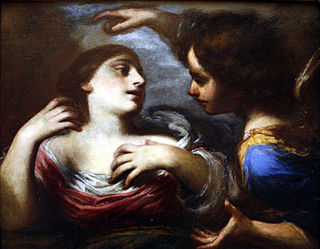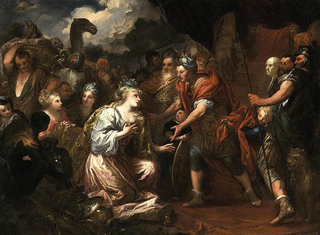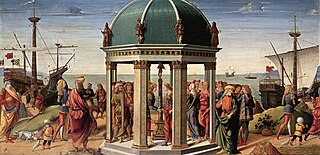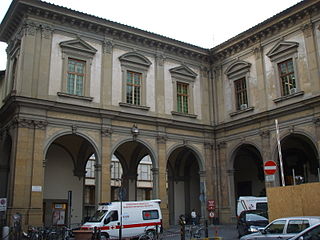Related Research Articles

Paolo Uccello, born Paolo di Dono, was a Florentine painter and mathematician who was notable for his pioneering work on visual perspective in art. In his book Lives of the Most Excellent Painters, Sculptors, and Architects, Giorgio Vasari wrote that Uccello was obsessed by his interest in perspective and would stay up all night in his study trying to grasp the exact vanishing point. While his contemporaries used perspective to narrate different or succeeding stories, Uccello used perspective to create a feeling of depth in his paintings. His best known works are the three paintings representing the battle of San Romano, which were wrongly entitled the Battle of Sant'Egidio of 1416 for a long period of time.

Andrea del Castagno or Andrea di Bartolo di Bargilla was an Italian painter from Florence, influenced chiefly by Masaccio and Giotto di Bondone. His works include frescoes in Sant'Apollonia in Florence and the painted equestrian monument of Niccolò da Tolentino (1456) in the Cathedral in Florence. He in turn influenced the Ferrarese school of Cosmè Tura, Francesco del Cossa and Ercole de' Roberti.

Domenico di Michelino (1417–1491) was an Italian Renaissance painter who was born and died in Florence. His real name was Domenico di Francesco. The patronymic "di Michelino" was adopted in honor of his teacher, the cassone painter Michelino di Benedetto, by whom no works have been identified. Giorgio Vasari reports that Domenico was also a pupil of Fra Angelico, whose influence is reflected in many of Domenico's paintings along with that of Filippo Lippi and Pesellino.

Ridolfo di Domenico Bigordi, better known as Ridolfo Ghirlandaio was an Italian Renaissance painter active mainly in Florence. He was the son of Domenico Ghirlandaio.

Bernardino Poccetti, also known as Barbatelli, was an Italian Mannerist painter and printmaker of etchings.

The church of San Giovannino degli Scolopi is a minor church in the center of Florence, located on Via Martelli corner with Via Gori.

Francesco Curradi or Currado was an Italian painter of the style described as Counter-Maniera or Counter-Mannerism, born and active in Florence.

Cecco Bravo was an Italian painter of the Florentine Baroque school. His true name is Francesco Montelatici.

Giovanni da San Giovanni, also known as Giovanni Mannozzi, was an Italian painter of the early Baroque period.

Pietro Dandini was an Italian painter of the Baroque period, active mainly in Florence.

Biagio d’Antonio Tucci was an Italian Renaissance painter active in Florence, Faenza and Rome.

The Hospital of Santa Maria Nuova is the oldest hospital still active in Florence, Italy.

The Barbadori Chapel, later Capponi Chapel, is a chapel in the church of Santa Felicita in Florence, central Italy. It was designed by Filippo Brunelleschi, and was later decorated by a cycle of works by the Mannerist painter Pontormo.

The Adoration of the Magi is a painting by the Italian Renaissance master Domenico Ghirlandaio, executed around 1485-1488 and housed in the Ospedale degli Innocenti gallery in Florence, Italy. The predella, painted by Bartolomeo di Giovanni, is in the same site.

Nicolò Barabino (1831–1891) was an Italian academic painter of religious and historical subjects, active in Florence and Genoa.

Francesco Corneliani (1740-1815) was an Italian painter, mainly active in a Neoclassic style in his native Milan.
Angelo Pietrasanta (1837–1876) was an Italian painter, mainly of historical canvases.

Niccola Cianfanelli was an Italian painter and restorer. He mainly painted historic and sacred subjects in a Neoclassical style.

Giovanni Maria Ciocchi was an Italian painter and art critic, active during the Baroque period. He was born into a family of artists, and it is not clear if he is related to Giovanni Maria Ciocchi del Monte from Perugia, who became Pope Julius III. it is not clear that Giovanni Maria is related to the 16th century painter Ulisse Ciocchi.

The Pinacoteca Civica di Palazzo Volpi is the town art gallery on Via Diaz 84 in the town of Como, Lombardy, Italy. It is housed in the 17th-century Palazzo Volpi.
References
- ↑ Trecanni Encyclopedia short biography.
- ↑ Guida pittorica ossia analisi intorno lo stile delle diverse scuole di pittura e degli artisti italiani e stranieri antichi e moderni, by Alessandro Petti; Publisher N. Fabricatore, Naples,1855, page 52.
- ↑ Sinite Parvulos, Gesù che benedice i fanciulli, Spedale degli Innocenti, Florence, Restoration.
| This article about an Italian painter born in the 18th century is a stub. You can help Wikipedia by expanding it. |